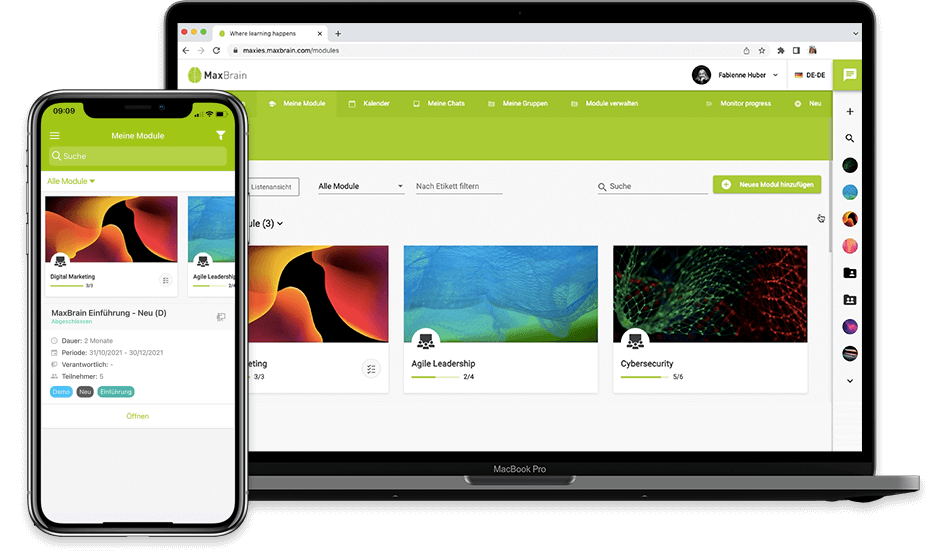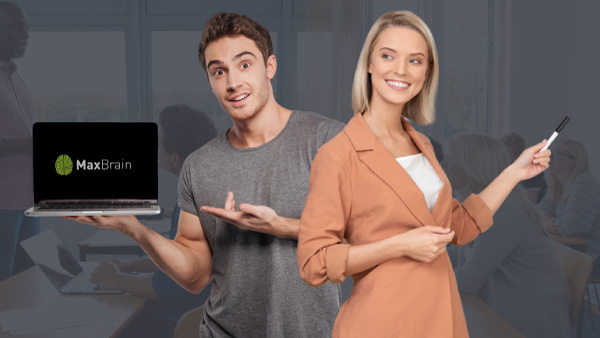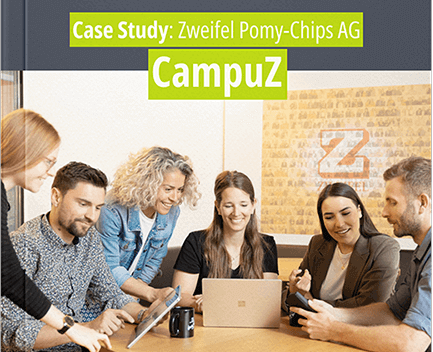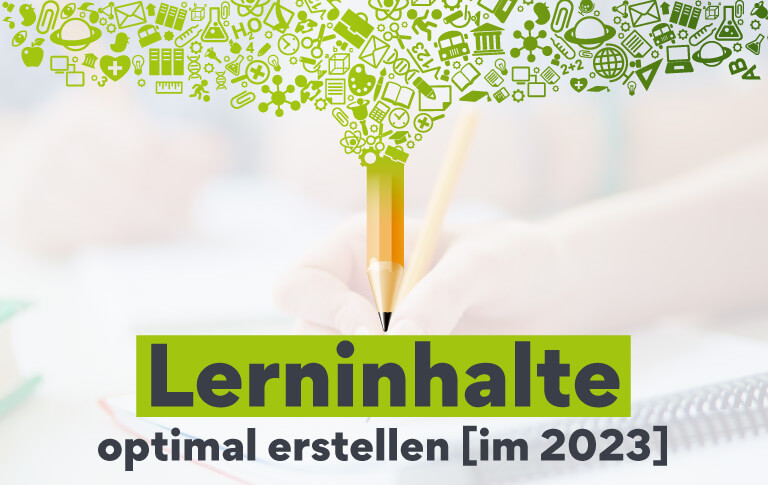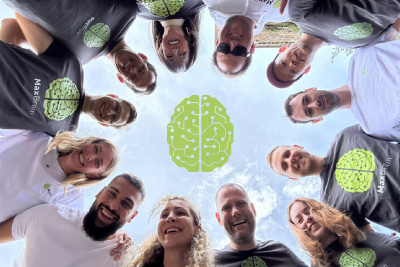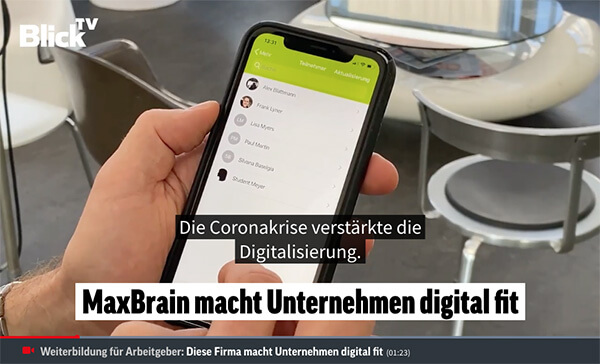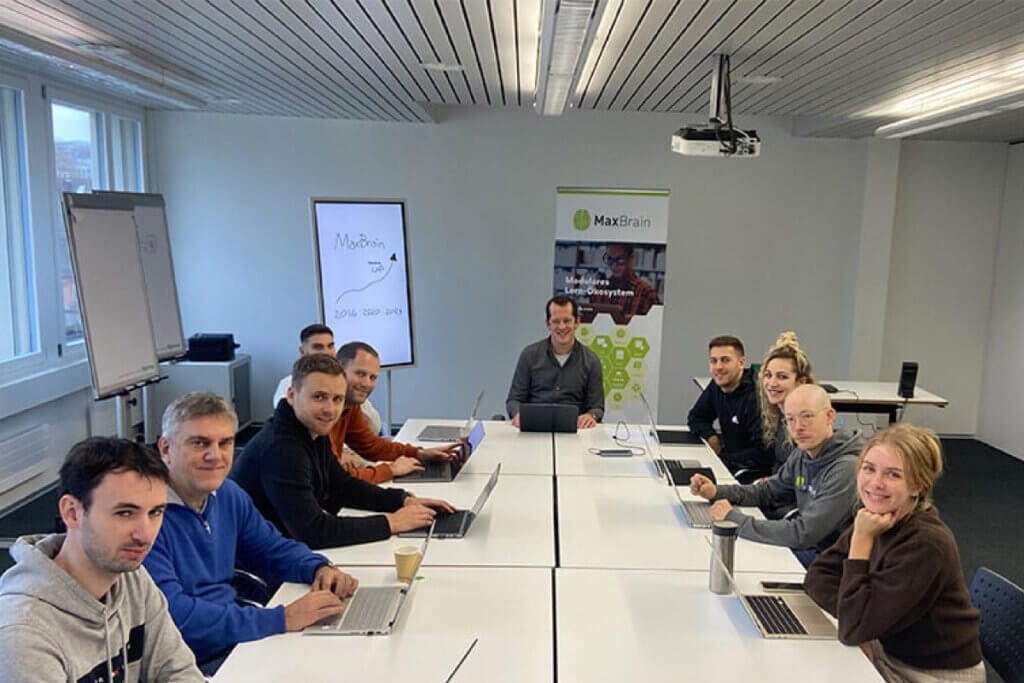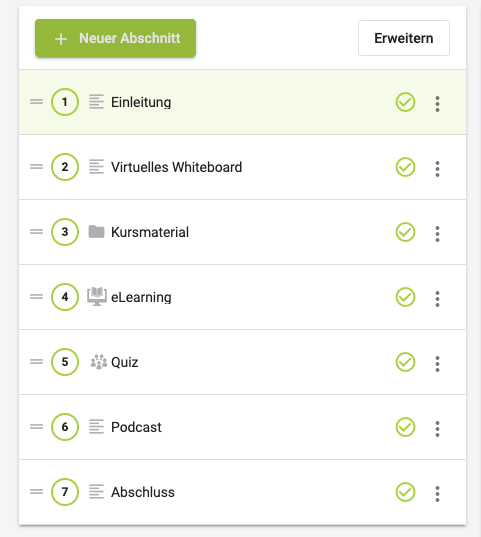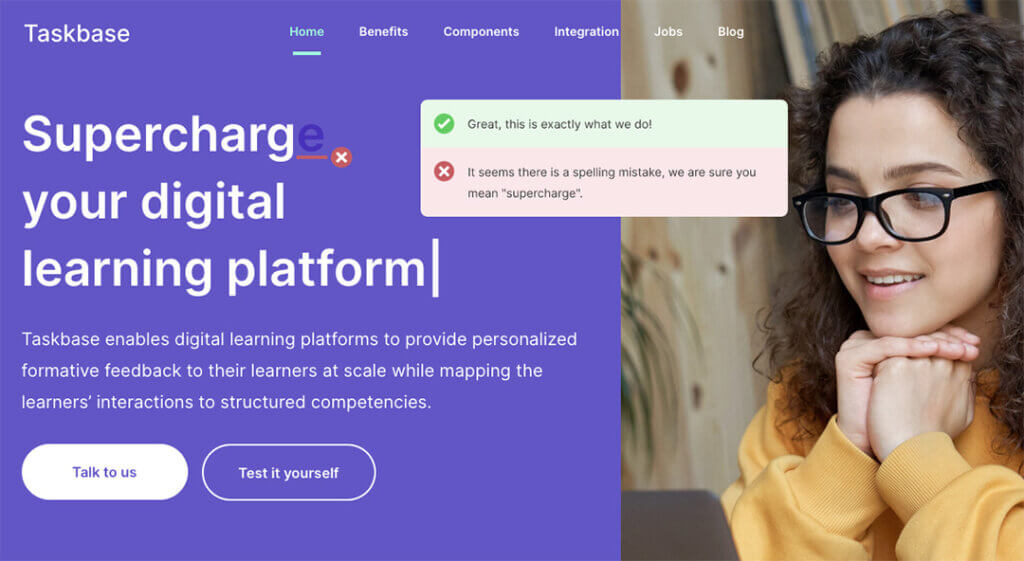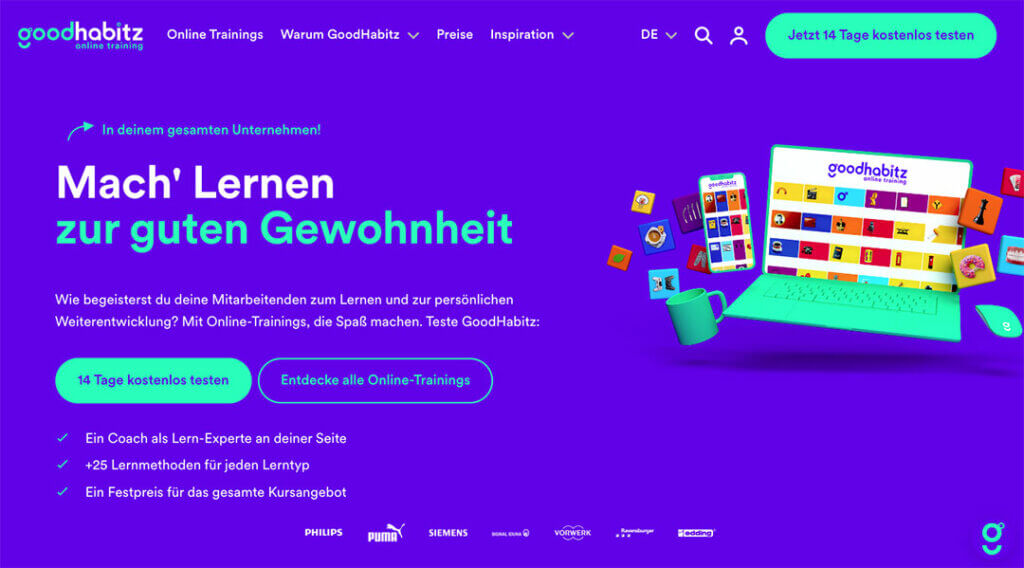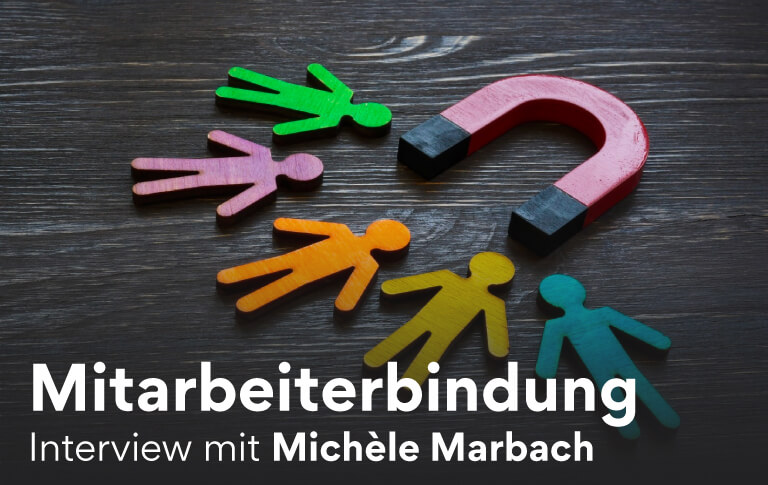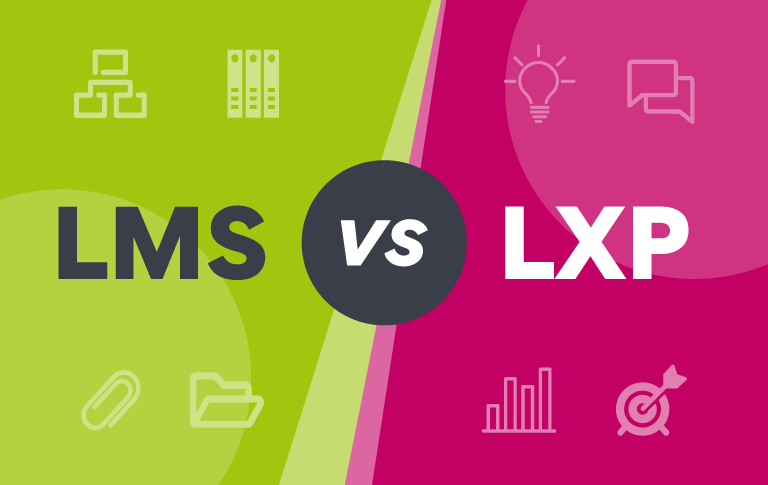Learning content is the essence of every learning platform, every company academy and every training and development initiative for employees.
But creating learning content that is really valuable is challenging.
Time, didactic know-how, experience and much more are required.
As a provider of a Learning Management System(LMS), we at MaxBrain are asked every day how to create learning content in the best possible way and what to look out for.
In this article, we would like to share our best recommendations.
1. define the objectives of the learning content
"Setting goals" always sounds good, but is not easy in practice.
To find the right targets, it is worth starting with a simple question:
Why do you want to train employees at all? -
Start with the "Why".
The answer to this and the associated key figures are usually very different.
Here are a few examples:
1.1 Frequent, short-term measurable objectives of learning content
Short to medium-term measurable goals for further training, which we at MaxBrain often work on with our customers:
Provide must-have knowledge, e.g. on topics such as occupational safety, data protection, compliance or IT security. Very simple, binary key figures count here: Has an employee completed these courses or not? - How many employees have completed mandatory course XY by when? etc.
Optimize onboarding and time to competency: Making the training of new employees faster and more efficient. An increasingly common key figure for this is "time to competency". It shows how quickly skills are acquired and, for example, how quickly new employees are fully operational.
Training existing employees on new products or work tools: This goal often affects all departments from Marketing, Sales, Customer Support, Finance, Human Resources, etc. - The metrics associated with product training can be very diverse and measured differently depending on the function of employees.
Increase sales performance: Increase turnover through better trained sales staff. The goal here is usually clearly defined: To increase turnover per sales employee.
Reducing support costs: Some of MaxBrain's business customers systematically reduce support costs with learning content and our learning platform. The learning content does not primarily serve the employees, but the customers and partners who have to use and maintain the product - e.g. a complex robotics application. The aim is to reduce the number of support tickets.
1.2 Frequent longer-term measurable objectives of learning content
Longer-term goals, on the other hand, are usually more abstract, less clearly measurable and aimed at strengthening the foundations of a company. However, if a company wants to position itself sustainably, such goals are often essential.
Frequent examples at MaxBrain:
Improve employer branding: Companies that make an effort to train employees attract more talent, which is often characterized by the desire for further training as such.
Establishing a shared learning culture as a general, long-term concept for success.
Strengthen employee motivation through inspiring new insights.
2. define and understand target groups
Good learning content is geared towards its target groups.
Even this simple recommendation can be challenging to implement:
Depending on lifestyle, length of service, department, previous education, age, language, gender, experience, interests, comprehension or even technical capabilities, target groups can be very different.
For example, there are professional groups - such as in logistics, production or field service - who, unlike their colleagues in the office, hardly need their own desktop computer for their work, follow a tightly scheduled daily routine and can be reached digitally almost exclusively via mobile devices. For these target groups, only shorter learning content that can be consumed quickly and accessed on the move is an option.
Colleagues who sit in front of a wide screen all day, on the other hand, are more likely to be motivated by learning content that takes a little longer and is optimized for desktop computers.
What is the best way to solve the problem of different target groups?
The answer:
By identifying and involving important and typical representatives from these target groups at an early stage. - Important are not only personalities in management positions, but also employees whose opinions are listened to by others: A company's "influencers".
3. determine teaching method
The creation of learning content should keep the teaching method or form of teaching in mind.
There are three different types of learning forms:
1. pure online learning, also known as e-learning: Learners attend an online course regardless of time and place.
2. pure face-to-face teaching: learners are taught at a training location by instructors, teachers or experts.
3. hybrid forms of teaching, also known as "blended learning": Learners can attend online courses and receive varying degrees of support from instructors, teachers or experts.
Depending on the teaching method, different learning content makes sense.
With pure e-learning, it is important that courses and learning content can be completed independently and in full by learners. The balance between "too easy" and "too demanding" must be maintained: Both extremes can quickly lead to learning content being negatively evaluated by learners.
Face-to-face teaching or blended learning, on the other hand, enable learning content in the form of individual explanations from teachers. The above-mentioned balance between "too easy" and "too demanding" is less critical.
4. create learning content
Once the above-mentioned objectives, target groups and teaching methods have been worked out, the more extensive work begins:
The creation of learning content that inspires.
Of course, there is a whole bouquet of recommendations that we at MaxBrain could present from our work with customers.
The most important and exciting recommendations are briefly outlined here:
4.1 Relevance for learners is priority 1.
Learning content that is not relevant to learners will hardly ever inspire them: everyday life is too hectic, there is too little time for irrelevant things.
The relevance of learning content is the first priority when creating learning content.
Learning content gains relevance by helping learners to progress; professionally, personally or both.
What "moving forward" means in the context of the relevance of learning content can be visualized in a learning curve:
The learners have a current level of knowledge, which forms the starting point.
This level of knowledge needs to be understood precisely:
If you do not correctly assess the level of education of the learners, you run the risk of offering learning content that is either too banal or too demanding. Both extremes lead directly to learning content not being relevant.
In order to understand the level of knowledge of learners, it is worth asking them.
Our recommendation:
Conduct surveys to find out which topics are of interest and which really help learners progress. Take into account the different target groups, as explained above.
However, the level of knowledge is only the starting point for determining relevance.
In order to move learners forward, you need to understand not only the starting point but also the goal or at least the direction in which the learning content should lead learners.
A classic example: sales training
If you offer your sales team cooking courses, you are setting a direction. At best, however, the learners will eat better and at best increase the team spirit.
These learners will probably not become better and sell more - the more attractive goal for your organization - with cooking courses alone.
Let us assume that the goal is defined as follows:
The sales team should sell better and more thanks to further training.
You can even define specific figures here: XX% more turnover per sales employee per quarter.
Next, check the level of knowledge of your sales staff:
You realize that the basic features of your products have already been mastered, that every member of your sales team is a strong communicator and knows that it's all about offering customers benefits.
If you offer this group courses or learning content about the importance of selling a customer advantage, the learning content will probably be judged as too banal and immediately lose relevance.
However, in the course of discussions with sales managers and individual salespeople, you discover that specific topics are still insufficiently mastered.
For example, the sales team is still somewhat under-trained when it comes to special steps in the sales process such as objection handling, price negotiations or closing techniques concerns.
Consequence:
In this case, the creation of learning content will focus entirely on these topics that are relevant to the performance of your sales team. - This will inspire your learners and bring you much closer to your goal of increasing your company's turnover.
4.2 Relevance for your organization: The pyramid
In addition to relevance for learners, relevance for your organization is key.
In discussions with organizations from a wide range of industries and cultures, we at MaxBrain almost always rely on visualization using a learning pyramid.
This then looks like this, for example:
The learning pyramid arranges the knowledge that an organization needs along two dimensions.
a.) A vertical dimension that differentiates between must-haves, specialist knowledge, soft skills and values.
b.) A horizontal dimension that differentiates between company-specific and general knowledge. - This distinction is later relevant when it comes to the question of whether learning content can be produced individually or purchased on the market. More on this below.
4.3 Storytelling
It should be common knowledge that people like stories. They prefer stories to endless theoretical treatises.
"Storytelling" is on everyone's lips.
What makes a good story is somewhat less well known.
A good story is usually characterized by the following factors:
Setting: A specific setting or background in which the story takes place.
Characters: The heroines or heroes, as well as secondary characters with whom you can identify or at least understand well.
Problem: The problem or conflict that the characters are confronted with within the setting.
Solution: The general solution to the problem.
Plot: The way in which characters actually implement the solution.
Next time you watch a movie, read a news item or read a novel: Pay attention to these elements. The mainstream always defines a good story by these elements.
The same applies to the "story" of learning content:
1) Describe a situation and characters that learners identify with or understand.
2) Formulate the conflict these characters face and the general resolution of it.
3) Then show how these characters implemented the solution.
4.4 Bring examples, examples, examples
Explanations work best with examples. Take the opportunity to pay attention to how you explain something to someone:
The theoretical principles, causes, reasons and correlations may be clear to you.
As soon as you communicate this to other people, concrete examples are often the only way to communicate your theory effectively.
Our clear recommendation:
Always give examples of abstract basics.
4.5 Surprise learners with new, original learning content.
The feedback "I already know" can be devastating for the acceptance of learning content and the enthusiasm of your learners. Banal common-sense learning content immediately discredits all your efforts.
The best learning content is original, novel and inspiring.
Inspiring learning content usually has the following characteristics in common:
1. relevance: Inspiring learning content is relevant. Please note the explanations above, which automatically mean that content is new.
2. emotional: Inspiring learning content is emotional and tells stories. See storytelling above.
3. justified: People love reasons. The why of a thesis therefore helps to make a thesis sound more inspiring. A thesis with a poor or superficial justification is still more inspiring than a thesis without a justification.
4.6 Provide structure: learning content along varied learning paths
People like structure; without it they quickly feel disoriented.
Structures make sense for all the topics mentioned above, especially for relevance.
Specifically, we always recommend structuring learning content in the form of learning paths.
With learning paths you define the path of a course; step by step from simple to challenging learning content.
The learning content along a learning path can also vary in your format.
Variety keeps learners interested.
Provide text followed by images and videos. Create quizzes from time to time to ensure that the basics are mastered before more challenging content is taught.
If you use a modern Learning Management System (LMS), such formats and learning content are easy to combine.
4.7 In a nutshell: Learning Nuggets
Time and patience: two scarce commodities in our society.
So-called "learning nuggets" are therefore becoming increasingly popular at MaxBrain: short, exciting learning units, summaries or short versions of more extensive courses.
KISS: Keep it short and simple is a proven principle for the creation of learning content.
In any case, make sure that you offer enough learning nuggets.
The majority of learners will be grateful.
Those who prefer in-depth and detailed learning content will not complain about a learning nugget in between.
4.8 Offer interaction and a dynamic learning culture
Countless organizations today rely on static PowerPoint presentations or PDFs for employee training.
Whether and how well employees learn the content of such static documents, whether the content is inspiring, how quickly knowledge is acquired, what it brings and many other questions are almost impossible to answer.
If you want to build a dynamic learning culture that will shape the success of a company in the medium to long term, you need interactive learning platforms with quizzes, learning checks, learning paths, certificates and much more. In the blog post "What makes a good LMS? (for 2023+)", I set out what a good, interactive learning platform needs to achieve.
The fact is that interaction leads to a much higher level of "engagement" among learners. Instead of just passively consuming teaching content, learners are challenged, can see their own learning progress, are rewarded for it and are therefore much more motivated.
The "time to competency" indicator, which is important for many companies, i.e. the time an employee needs to learn a new skill, is optimized through interaction.
Offer learning content and learning paths that involve interaction.
4.9 Repetition, repetition, repetition
You may remember from your school days: learning needs repetition.
Apart from a few privileged people with a photographic memory, most of us cannot memorize learning content at first sight.
And if you don't remember something later, you won't learn it.
As was the case when learning material at school, repetition in a varied form is crucial for learning success in continuing education.
Don't be afraid of "boredom" with repetition. It is better to repeat teaching content once too often than to have learners who immediately forget what they have learned.
4.10 Offer summaries
Summaries are popular learning content, both before as well as after a course.
Our clear recommendation is therefore:
Make life easier for learners and provide summaries to quickly grasp what the key takeaways of a course are.
4.11. Learning objective tests and quizzes
When I was young, it was still called a "test" or "exam". In the meantime, the somewhat broader term "learning objective assessment" has become established in Swiss schools.
"Learning objective checks" or - in more playful terms - "quizzes" offer both learners and teachers the opportunity to better understand whether learning content has been successfully mastered or not.
Learning objective checks or simple quizzes are therefore among the most important interactive learning content.
The tool we recommend for this is Classtime.
There are also very useful systems that provide immediate feedback for each task and help learners to recognize their mistakes immediately. The tool recommended by MaxBrain for this is TaskBase.
4.12. Motivation: Convey a good feeling
Learning content should motivate and inspire.
Aside from the ideas above, there are numerous other factors to make learning content feel good. For example:
Language: Use language that is as positive and constructive as possible
Create variety by combining text, images, videos, quizzes, etc.
Explain relevance: Provide brief explanations of why a learning content is important for the learner.
Praise: Explicitly praise learners for their learning progress from time to time.
Offer certificates for completed courses or learning units that learners can be proud of.
4.13. Design visualizes quality
Design is a decisive factor in how the quality of learning content is perceived. A top design conveys the impression of quality more quickly, regardless of all the points mentioned above. - Conversely, very good learning content can be perceived as inferior if the design looks inferior. It is therefore worth paying attention to fonts, colors, imagery and investing in graphic consistency across all learning content. Our two recommendations:1. define a uniform, high-quality design style from the outset.
2. create templates and use these templates consistently across all learning content.
4.14. Optimize learning content: Collecting, evaluating and utilizing feedback
Good teaching content is the result of experience and, in some cases, years of optimization.
Organizations that employ a large number of employees and have already established a learning culture optimize learning content "on the go". This means that learning content is first tested in smaller, representative groups.
Thanks to systematic feedback, the learning content is optimized.
The subsequent learners thus benefit from a "proof of concept", high quality and practical relevance.
In my experience, getting feedback on learning content is always worthwhile:
The professional training centers that work with MaxBrain prove this every day: companies such as WEKA, Goethe Business School and VEB.ch all consistently rely on feedback after every course.
From a technical point of view, tools such as SurveyMonkey in combination with a professional learning platform offer a simple way of collecting and evaluating feedback.
Thanks to systematic feedback, the learning content is optimized.
5. build or buy - you don't have to create every course yourself!
There is now a whole industry of providers offering learning content or suitable intermediate solutions.
(A) Public platforms: Platforms such as YouTube or Udemy inherently offer a seemingly endless selection of learning nuggets. However, the vastness of the offer there is a challenge: Picking out the really good, original learning content can quickly become challenging.
(B) Specialized providers of general knowledge: For their part, providers such as GoodHabitz or Elucydate offer high-quality, ready-to-use e-learning. In contrast to YouTube or Udemy, the courses offered are more focused on the success of organizations. In addition, learning content is carefully curated and optimized over the years.
(C) Training centers: Institutes for professional development such as WEKA, Goethe Business School or Digicomp train tens of thousands of people every year on specific topics relevant to their profession. In addition to face-to-face teaching, such organizations also offer hybrid teaching formats such as blended learning and organize individual in-house courses at organizations themselves if required.
(D) Specialized agencies: Agencies specializing in learning content, such as Somedia Learning in Switzerland or ML Gruppe in Germany, create didactically high-quality, individual courses for organizations, industrial companies and authorities. So if you need individual, company-specific courses, you can order them there.
You do not have to create all learning content yourself. You can also buy learning content or have it produced by third-party providers.
In addition to saving time, you benefit from years of experience and proven quality when purchasing learning content from external providers.
My recommendation:
1. talk to specialists about how you can create the best learning content.
2. test third-party learning content, especially when it comes to general knowledge, which is already available in very high quality from specialized providers such as GoodHabitz or Elucydate.
3. get quotes for the creation of individual courses from professional agencies that specialize in learning content.
Questions for you:
Now I would like to hear from you:
Which tips from this article do you find particularly valuable?
What other recommendations would you give for the creation of learning content?
Please leave a comment on LinkedIn:
Did you like this article?
If so, please share this article on your social media channels. Thank you very much!
